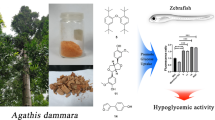Summary
Extracts of corpora cardiaca from two members of the family Tenebrionidae,Zophobas rugipes andTenebrio molitor, from one member of the Chrysomelidae,Leptinotarsa decemlineata, and from three members of the Scarabaeidae,Pachnoda marginata, P. sinuata andMelolontha hippocastani, were assayed for adipokinetic and hypertrehalosaemic activity in acceptor locusts (Locusta migratoria) and cockroaches (Periplaneta americana), respectively. All corpus cardiacum material tested, except that from the cockchafer,M. hippocastani, gave positive bioassay results. Biological activities of corpus cardiacum extracts from all species investigated can be resolved on reversed-phase high performance liquid chromatography (RP-HPLC). Gland extracts from the two tenebrionid species each show a single peak of biological activity associated with a single peak of UV absorbance having an identical retention time in both species. The two biologically active fractions from the corpora cardiaca of the potato beetle,L. decemlineata, coelute with exogenous (synthetic) hypertrehalosaemic hormones I and II of the American cockroach. The two species of the genusPachnoda contain two active compounds in their glands; compound I of each species is more abundant and elutes just ahead of the (synthetic) hypertrehalosaemic hormone of the cockroachBlaberus discoidalis. The gland material ofM. hippocastani exhibits and absorbance peak with the same retention time as the major peak from thePachnoda-species; however, this peak material does not elicit biological activity in the assays used here. After fractionation by RP-HPLC the main biologically active compounds were subjected to amino acid analyses. All factors are peptidic and contain 8 amino acid residues. The peptides from the tenebrionid species have the amino acid residues Asx(2), Glx(1), Ser(1), Pro(1), Leu(1), Phe(1) and Trp(i), whereas the main peptide from corpora cardiaca ofP. marginata contains the residues Asx(2), Glx(1), Ser(1), Pro(1), Tyr(1), Leu(1) and Trp(1). Amino acid composition analyses of the two active fractions fromL. decemlineata reveal the residues Asx(2), Glx(1), Ser(1), Pro(1), Val(1), Phe(1) and Trp(1) for compound I and Asx(1), Glx(1), Thr(2), Pro(1), Leu(1), Phe(1) and Trp(1) for compound II.
Similar content being viewed by others
References
Dallmann SH, Herman WS (1978) Hormonal regulation of haemolymph lipid concentration in the Monarch butterfly,Danaus plexippus. Gen Comp Endocrinol 32:142–150
Gäde G (1980) Further characteristics of adipokinetic and hyperglycaemic factor(s) of stick insects. J Insect Physiol 26:351–360
Gäde G (1984) Adipokinetic and hyperglycaemic factors of different insect species: separation with high performance liquid chromatography. J Insect Physiol 30:729–736
Gäde G (1985a) Isolation of the hypertrehalosaemic factors I and II from the corpus cardiacum of the Indian stick insect,Carausius morosus, by reversed-phase high-performance liquid chromatography, and amino-acid composition of factor II. Biol Chem Hoppe-Seyler 366:195–199
Gäde G (1985b) Amino acid composition of cockroach hypertrehalosaemic hormones. Z Naturforsch 40c:42–46
Gäde G (1985c) Hypertrehalosaemic hormones and myoactive factors from cockroach corpus cardiacum are very likely identical. Naturwissenschaften 72:95–96
Gäde G (1988a) New structures of insect neuropeptides. In: Sehnal F, Zabza A, Denlinger DL (eds) Endocrinological frontiers in physiological insect ecology. Wroclaw Technical University Press, Wroclaw, pp 635–650
Gäde G (1988b) Studies on the hypertrehalosaemic factor from the corpus cardiacum/corpus allatum complex of the beetle,Tenebrio molitor. Comp Biochem Physiol 91A:333–338
Gäde G, Goldsworthy GJ, Kegel G, Keller R (1984) Single step purification of locust adipokinetic hormones I and II by reversed-phase high-performance liquid chromatography, and amino-acid composition of the hormone II. Hoppe Seyler's Z Physiol Chem 365:393–398
Gäde G, Hilbich C, Beyreuther K, Rinehart KL (1988) Sequence analyses of two neuropeptides of the AKH/RPCH-family from the lubber grasshopper,Romalea microptera. Peptides 9:681–688
Gäde G, Scheid M (1986) A comparative study on the isolation of adipokinetic and hypertrehalosaemic factors from insect corpora cardiaca. Physiol Entomol 11:145–157
Gäde G, Rinehart KL Jr (1986) Amino acid sequence of a hypertrehalosaemic neuropeptide from the corpus cardiacum of the cockroachNauphoeta cinerea. Biochem Biophys Res Commun 141:774–781
Goldsworthy GJ, Gäde G (1983) The chemistry of hypertrehalosaemic factors. In: Laufer H, Downer RGH (eds) Endocrinology of Insects. Alan R Liss, New York, pp 109–119
Goldsworthy GJ, Mordue W, Guthkelch J (1972) Studies on insect adipokinetic hormones. Gen Comp Endocrinol 18:545–551
Hayes TK, Keeley LL, Knight DW (1986) Insect hypertrehalosaemic hormone: Isolation and primary structure fromBlaberus discoidalis cockroaches. Biochem Biophys Res Commun 140:674–678
Heinrikson RL, Meredith SC (1984) Amino acid analysis by reverse-phase high performance liquid chromatography. Precolumn derivatization with phenylisothiocyanate. Anal Biochem 136:65–74
Orchard I (1987) Adipokinetic hormones—an update. J Insect Physiol 33:451–463
Raina AK, Gäde G (1988) Insect peptide nomenclature. Insect Biochem 8:785–787
Rosinski G, Gäde G (1988) Hyperglycaemic and myoactive factors in the corpora cardiaca of the mealworm,Tenebrio molitor. J Insect Physiol 34:1035–1042
Scarborough RM, Jamieson GC, Kalish F, Kramer SJ, McEnroe GA, Miller CA, Schooley DA (1984) Isolation and primary structures of two peptides with cardioacceleratory and hyperglycaemic activity from the corpora cardiaca ofPeriplaneta americana. Proc Natl Acad Sci USA 81:5575–5579
Spik G, Montreuil J (1964) Deux causes d'erreur dans les dosages colorimetriques des oses neutres totaux. Bull Soc Chim Biol 46:739–749
Wheeler CH, Gäde G, Goldsworthy GJ (1988) Humoral functions of insect neuropeptides. In: Thorndyke MC, Goldsworthy GJ (eds) Neurohormones in invertebrates. Society for Experimental Biology Seminar Series, Vol 33. University Press, Cambridge, pp 141–157
Witten JL, Schaffer MH, O'Shea M, Cook JC, Hemling ME, Rinehart KL Jr (1984) Structures of two cockroach neuropeptides assigned by fast atom bombardment mass spectrometry. Biochem Biophys Res Commun 124:350–358
Zöllner N, Kirsch K (1962) Über die quantitative Bestimmung von Lipoiden (Mikromethode) mittels der vielen natürlichen Lipoiden (allen bekannten Plasmalipoiden) gemeinsamen Sulfophosphovanillin-Reaktion. Z Ges exp Med 135:-545–561
Author information
Authors and Affiliations
Rights and permissions
About this article
Cite this article
Gäde, G. Characterisation of neuropeptides of the AKH/RPCH-family from corpora cardiaca of Coleoptera. J Comp Physiol B 159, 589–596 (1989). https://doi.org/10.1007/BF00694384
Accepted:
Issue Date:
DOI: https://doi.org/10.1007/BF00694384




